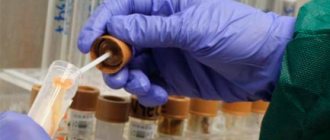Detailed description of the study
The main function of the female reproductive system is to ensure a successful pregnancy, pregnancy and birth of a child. The uterus is the organ where fetal maturation occurs. Its lower segment, partially protruding into the vaginal cavity, is called the cervix. The vaginal part of the cervix is accessible for inspection during examination on a gynecological chair and has the shape of a cylinder with a cavity inside - the cervical canal.
This canal opens on one side into the uterine cavity (internal os) and into the vagina on the other (external os). Inside, it has a lining in the form of a cylindrical epithelium, the cells of which produce mucus. The amount and consistency of mucus is regulated by hormones. So, in the middle of the menstrual cycle, that is, during ovulation, the outflow of mucous secretions increases, they become less thick, which ensures the penetration of sperm into the uterus.
The female reproductive system is designed in such a way as to ensure the successful conception of a child and its bearing. Each of its organs performs its own function. The vagina mainly provides a protective role and outflow of menstrual blood. It is connected to the uterus through the cervical canal, or cervical canal.
A large number of microorganisms live inside the cervical canal. The composition of the microflora of the cervix is in many ways similar to that in the vagina. Its dominant representatives are bacteria, but viruses and fungi can be found.
Among the bacteria of the cervical canal, lactobacilli, or lactobacilli, predominate. They belong to the representatives of the normal, or eubiotic, microflora of the vagina. In addition to them, representatives of opportunistic microflora may exist in the cervical canal: streptococci, bacteroides, gardnerella and others. They help maintain the species diversity of the flora, but if they multiply excessively, they can cause harm to the body.
Lactobacilli ensure the maintenance of an acidic environment in the vagina, secrete substances that cause the death of pathogenic microorganisms and suppress the excessive growth of opportunistic microorganisms. A microbial imbalance in the vagina contributes to the development of a disease called bacterial vaginosis. It is manifested by inflammation of the vagina and cervix due to a decrease in the amount of normal flora and an increase in the number of unwanted microorganisms.
Women complain of an unpleasant odor from the genital tract, discomfort in the vagina, and excessive discharge from it. Having bacterial vaginosis during pregnancy may increase the risk of preterm birth. The presence of the bacterium Streptococcus agalactiae in the structure of the microflora is especially unfavorable, since this microorganism, when introduced to a newborn, can cause lung damage.
Bacteriological examination (bacterial culture) of the material obtained by taking a smear from the cervical canal is one of the most common tests used by gynecologists. The presence of bacterial vaginosis, confirmed by analysis data, may require specific therapy with antibiotics or bacteriophages - drugs based on viruses that cause the death of certain bacteria. In view of this, the present study evaluates the sensitivity of microflora to these therapeutic agents.
The procedure for taking a smear is performed in the Gemotest laboratory on the day of application. You can find out more about the price of the test, the time required to complete it, and the specifics of preparation on the website or by contacting any department of the laboratory.
Preparation and execution
The procedure for taking biomaterial is practically painless, so it is performed without anesthesia. A day before the procedure, you should avoid sexual intercourse, do not use vaginal medications, or douche.
During the analysis, biomaterial for sowing is taken with a special brush-probe, which is inserted 1-1.5 cm into the cervical canal. Then it is removed and immersed in a test tube with a nutrient medium. The inoculated tube is kept in conditions favorable for reproduction for 2-3 days, and the resulting liquid is examined under a microscope. The analysis is deciphered by a microbiologist who identifies pathogenic and opportunistic bacteria. Having detected pathogenic microorganisms, the doctor can prescribe specific, effective treatment.
When choosing a clinic for testing, two points are taken into account - the equipment of the laboratory and the level of qualifications of the staff. The laboratory in which the analysis is carried out must be equipped in accordance with established standards - an air purification filter must be installed in the room. Personnel must be familiar with the instructions for collecting material and conducting research - this reduces the likelihood of diagnostic error to a minimum.
What else is prescribed with this study?
Comprehensive study of the microflora of the urogenital tract with determination of the sensitivity of the pathogen to an expanded range of antibacterial drugs and bacteriophages
170.0.01.39.02.3. Scraping 7 days
RUB 1,790 Add to cart
General urine analysis
9.1. Urine 1 day
330 RUR Add to cart
Femoflor Screen (Study of the microflora of the urogenital tract in women, 12 indicators), scraping
50.2.2087. Scraping 3 days
2,000 RUR Add to cart
Femoflor-8 (Study of microflora of the urogenital tract in women, 8 indicators), scraping
27.38. Scraping 3 days
RUB 1,990 Add to cart
Florocenosis (Study of microflora of the urogenital tract and diagnosis of STIs in women), scraping
28.92. Scraping 3 days
RUR 1,890 Add to cart
Preparing for analysis
Preparing for the study:
do not have sex the day before tests;- do not take medications (especially antibiotics) two weeks before the test;
- do not use creams or gels for intimate procedures;
- prepare and refrain from any hygiene procedures before submitting samples;
- do not go to the toilet before submitting samples;
- do not douche or use candles;
- wait a few days if colposcopy was performed;
- Do not take tests during your period, but 7 days after the end.
References
- Oliver, A., LaMere, B., Weihe, C. et al. Cervicovaginal Microbiome Composition Is Associated with Metabolic Profiles in Healthy Pregnancy. mBio, 2021. - Vol. 11(4).
- Kroon, S., Ravel, J., Huston, W. Cervicovaginal microbiota, women's health, and reproductive outcomes. FertilSteril., 2021. - Vol. 110(3). — P. 327-336.
- Prevention of group B streptococcal early-onset disease in newborns. ACOG Committee Opinion No. 797. American College of Obstetricians and Gynecologists. ObstetGynecol, 2021.
Tank seeding during pregnancy
Pregnant women need to take a bacterial test from the cervical canal.
After all, it is in this canal that pathogenic bacteria accumulate, which can harm the fetus.
In order for the pregnancy to proceed without problems and the child to be healthy, it is necessary to detect the infection in time and cure the disease.
But bacterial analysis from the canal is not prescribed to all pregnant women. When registering, women must undergo a general smear test.
And if the content of leukocytes in it is increased, then the doctor prescribes an additional test for culture. A high percentage of leukocytes indicates an inflammatory process. And which bacteria caused the disease can only be determined by analysis from the cervical canal.
mutual fund
PIF provides for the direct detection of chlamydia antigens.
The PIF method is the most important screening method for diagnosing urogenital chlamydia.
Indications for the purpose of analysis:
- Acute phase of the disease.
- Chronic phase of the disease.
- Establishing the etiology of a chronic infectious process of the urogenital tract.
- Pregnancy with a burdened obstetric history.
- Infertility of unknown origin.
Preparation for the study: In women, it is best to take biological material no earlier than 14 days after menstruation. Before taking the material, patients are advised to refrain from urinating for 1.5-2 hours.
Material for research: scraping from the urethra or cervical canal, urine sediment, prostate secretion.
The disadvantage of this method is the frequency of false positive results for chlamydia. When using the direct immunofluorescence method, a false-positive diagnosis of urogenital chlamydia is made in 36% of patients. In foreign practice, the diagnosis established by PIF is usually confirmed using a cultural study.
ELISA
An enzyme-linked immunosorbent assay aims to detect antibodies in the blood. Accordingly, the higher the titer, the more antibodies to a particular infectious disease. IgG antibodies indicate a previous infectious disease, and IgM antibodies indicate the presence of an acute infectious process. ELISA allows you to diagnose:
- viral infections: hepatitis, HIV infections, herpes virus, rubella, cytomegalovirus;
- bacterial infections: tuberculosis, borreliosis, syphilis;
- other diseases: giardiasis and toxoplasmosis.
Such a blood test is necessary to determine the stage of the disease, evaluate the effectiveness of treatment, and obtain information about a previous disease.
Controversy surrounding analysis
Expectant mothers are wary of bacterial testing. After all, the brush is inserted deep into the vagina and a smear is taken from the cervical canal. But taking a smear test cannot lead to a miscarriage.
The study is completely safe, but it is prescribed only when absolutely necessary. When assessing the state of the vaginal microflora, gynecologists use a special concept - the degree of purity.
There are 4 degrees of vaginal smear purity:
- Acidity is normal, lactobacilli predominate , there is no inflammation.
- Acidity is normal, a small number of leukocytes , the number of lactobacilli is reduced, diplococci are present.
- The environment is slightly acidic or alkaline , an increased number of leukocytes, a reduced number of lactobacilli, many coccal organisms.
- The environment is alkaline, a large number of leukocytes , the absence of positive and the presence of a huge number of dangerous microorganisms.
If a vaginal smear indicates problems, and the degree of purity is 3 or 4, then pregnant women are additionally prescribed a culture test from the cervical canal.
A normal culture of a pregnant woman should contain only beneficial microorganisms: lacto and bifido. A small amount of E. coli is allowed. There should be no yeast or bacteria present.
If an increased content of dangerous microorganisms is detected, then treatment is necessary. Therapy in the early stages of pregnancy gives good results.
PCR
PCR diagnostics, or polymerase chain reaction, is aimed at determining the specific nucleotide sequence of the DNA section of the infectious agent inside the cell, which cannot be achieved with a smear or bacterial culture. PCR analysis is often used to detect: chlamydia, ureaplasmosis, mycoplasmosis, herpes genius, gonorrhea, trichomoniasis. DNA diagnostics is indispensable for detecting viral hepatitis and HIV infection. This method is capable of identifying the pathogen even at the stage of the incubation period, but it does not give an idea of the activity of the virus, as ELISA does. In addition, PCR may not detect genital herpes and cytomegalovirus in vaginal scrapings if the virus is in “hibernation”; it is recommended to use an enzyme-linked immunosorbent assay to detect these infections. The rules for submitting material for PCR diagnostics are the same as for bacterial culture.
PCR is the most accurate and modern diagnostic method. A summary assessment of the sensitivity of various diagnostic methods carried out in several foreign research centers showed that “rapid” or express tests have a sensitivity of 40-60%, ELISA - 50-70%, direct immunofluorescence (DIF) - 55-75%, culture - 60-80%, and PCR from 90 to 100%.
Indicators are normal
The canal is populated by various microorganisms; it cannot be completely sterile. Lysozyme contained in the secretion of the canal has an antimicrobial effect.
Beneficial bacteria must be present in the cervix.
But just one harmful bacteria, for example, staphylococcus, indicates an infection and the need for treatment. The composition of the microflora depends on:
- on the age of the woman;
- presence of infection;
- hormonal levels;
- taking antibiotics;
- various pathologies.
The analysis provides data on the microorganisms inhabiting the cervix. A normal indicator should not contain any fungi or bacteria.
However, there must be beneficial bifidobacteria and lactobacilli, but not less than 10.7. Indicators of E. coli – 10.2 enterococci. Leukocytes are normal up to 30. Flat epithelium – 5-10. There should be a moderate amount of mucus.
Pathological is a condition in which a large number of E. coli, gonococci, yeast fungi, staphylococci, and trichomonas are found. This analysis is not able to detect chlamydia and ureaplasma.
Decoding the results
The gynecologist interprets the results obtained from the laboratory. The analysis shows the name of the microorganisms inhabiting the cervix, as well as one of the 4 levels of cleanliness of the canal.
There are 4 levels of channel purity:
- Microorganisms show little growth. They are present in liquid media, but not in solid media.
- Bacteria of one type show growth of up to 10 colonies on a hard surface.
- The number of bacteria is up to 100 colonies on a solid medium.
- The number of different colonies is more than 100.
The first two degrees indicate contamination of the canal, and the third and fourth degrees indicate inflammatory processes.
And the reasons for the increased number of bacteria in the cervix are decreased immunity, hormonal imbalances, taking antibiotics, hereditary diseases, poor hygiene, infection during sexual intercourse, infection due to medical procedures.
Tank culture for the presence of bacteria can also determine sensitivity to various antibiotics. Bacteria whose sensitivity needs to be determined are placed in a dish with a nutrient medium. Discs soaked in antibiotics are placed on the surface of the medium.
This antibiotic penetrates the environment and affects the growth of microorganisms. The bowl should stand for some time at room temperature, and then it is placed in a thermostat for several hours.
After the required amount of time has passed, the diameter of the growth inhibition zone is measured and the suppression of bacterial growth is assessed:
- the absence of growth inhibition indicates bacterial resistance to the drug;
- zone diameter up to 1.5 cm – weak reaction, low effectiveness of the product;
- zone diameter from 1.5 to 2.5 cm – moderate sensitivity;
- diameter greater than 2.5 cm – hypersensitivity to antibiotics.
It is important to determine sensitivity to antibiotics, because in different women, bacteria react differently to certain medications. You cannot prescribe medications based only on textbook recommendations. It is necessary to find out which antibiotic can cope with the disease.







